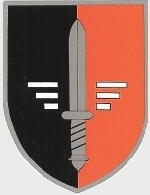Hobby Master HA8758 German Messerschmitt Bf 109G-6 "Gustav" Fighter - "Christl", Gerhard Barkhorn, II./Jagdgeschwader 52, Ukraine, September 1943 (1:48 Scale)
"For the last two and one-half years the bitter and costly struggle against Bolshevism has made the utmost demands upon the bulk of our military resources and energies. This commitment was in keeping with the seriousness of the danger, and the over-all situation. The situation has since changed. The threat from the East remains, but an even greater danger looms in the West: the Anglo-American landing! In the East, the vastness of the space will, as a last resort, permit a loss of territory even on a major scale, without suffering a mortal blow to Germany's chance for survival. Not so in the West! If the enemy here succeeds in penetrating our defenses on a wide front, consequences of staggering proportions will follow within a short time. All signs point to an offensive against the Western Front of Europe no later than spring, and perhaps earlier. For that reason, I can no longer justify the further weakening of the West in favor of other theaters of war. I have therefore decided to strengthen the defenses in the West, particularly at places from which we shall launch our long-range war against England. For those are the very points at which the enemy must and will attack; there--unless all indications are misleading--will be fought the decisive invasion battle."
- Fuhrer Directive No. 51, announcing preparations for a two-front war, November 3rd, 1943
 Numerically the most abundant fighter produced by either side during WWII, the Messerschmitt Bf 109 formed the backbone of the Jagdwaffe on both the eastern and western fronts, as well as in the Mediterranean and North Africa. Of the eight distinct sub-types within the huge Bf 109 family, the most populous was the G-model, of which over 30,000 were built between 1941-45. Despite its production run, only a handful of genuine German Bf 109s have survived into the 1990s, and with the serious damaging of the RAFs G-2 at Duxford in October 1997, only the German-based MBB G-6 and Hans Ditte's G-10 (both composites) are currently airworthy.
Numerically the most abundant fighter produced by either side during WWII, the Messerschmitt Bf 109 formed the backbone of the Jagdwaffe on both the eastern and western fronts, as well as in the Mediterranean and North Africa. Of the eight distinct sub-types within the huge Bf 109 family, the most populous was the G-model, of which over 30,000 were built between 1941-45. Despite its production run, only a handful of genuine German Bf 109s have survived into the 1990s, and with the serious damaging of the RAFs G-2 at Duxford in October 1997, only the German-based MBB G-6 and Hans Ditte's G-10 (both composites) are currently airworthy.
The G series, or Gustav, was introduced in mid-1942. Its initial variants (G-1 through G-4) differed only in minor details from the Bf 109F, most notably in the more powerful 1,475 PS (1,455 HP) DB 605 engine. Odd-numbered variants were built as high-altitude fighters with a pressurized cockpit and GM-1 boost, while even-numbered variants were un-pressurized, air superiority fighters and fighter-bombers. Long-range photo-reconnaissance variants also existed. The later G series (G-5 through G-14) was produced in a multitude of variants, with uprated armament and provision for kits of packaged, generally factory-installed parts known as Umrust-Bausatze (usually contracted to Umbau) and adding a "/U" suffix to the aircraft designation when installed. Field kits known as Rustsatze were also available for the G-series but those did not change the aircraft title. By early 1944, tactical requirements resulted in the addition of MW-50 water injection boost and high-performance superchargers, boosting engine output to 1,800-2,000 PS (1,775-1,973 HP). From early 1944, some G-2s, G-3s, G-4s and G-6s were converted to two-seat trainers, known as G-12s. An instructor's cockpit was added behind the original cockpit and both were covered by an elongated, glazed canopy.
Pictured here is a 1:48 scale replica of a German Messerschmitt Bf-109G-6 "Gustav" fighter that was piloted by Gerhard Barkhorn, who was attached to II./Jagdgeschwader 52, then deployed to the Ukraine during September 1943.
Now in stock!
Dimensions:
Wingspan: 8-inches
Length: 7-1/2-inches
Release Date: April 2023
 Historical Account: "To Soar With Eagles" - Gerhard Barkhorn is credited with the second highest victory tally in WWII, and is only one of two pilots to have reached the 300 level, the other being Erich "Bubi" Hartmann. For most of his combat career, Barkhorn served with JG 52, although he earned his come uppance in July 1939 with JG 2.
Historical Account: "To Soar With Eagles" - Gerhard Barkhorn is credited with the second highest victory tally in WWII, and is only one of two pilots to have reached the 300 level, the other being Erich "Bubi" Hartmann. For most of his combat career, Barkhorn served with JG 52, although he earned his come uppance in July 1939 with JG 2.
While his unit took part in the Battle of Britain, he was never able to score any victories in the skies over England. Afterwards, JG 52 was transferred to the Eastern Front in July 1941, where Barkhorn earned his first victory on the second of the month. This tally soon grew, reaching an astounding 52 kills by August 1942. For this he was awarded
"Das Ritterkreuz des Eisernen Kreuz" (Knights Cross of the Iron Cross). His count continued to soar, reaching 175 victories in January 1943, at which point he received the Oakleaves to his Knights Cross.
In September, he was promoted to the rank of
Gruppenkommandeur of II./JG 52. He reached the magical mark of 200 kills in November, and gained his 250th victory in February 1944, for which he received the Swords to his Knights Cross with Oakleaves. He eventually claimed 300 victories at the beginning of 1945 and his final kill, an incredible 301 victories, on January 5th, 1945.
On January 15th, he was promoted to the rank of Major and became
Geschwaderkommodore of JG 6. In April, he was moved to the "Jagdfliegerheim" for recuperation, before moving to JV 44 -- "The Squadron of Experts" -- under the tutelage of Johannes Steinhoff & Adolf Galland. Called upon to fly the jet-powered Me 262, he was forced to make a crash landing due to engine failure and heavy enemy opposition on April 17th, which left him seriously injured. The injury would put an end to his flying career, which stood at an incredible 1,104 combat missions, spanning much of Continental Europe.


